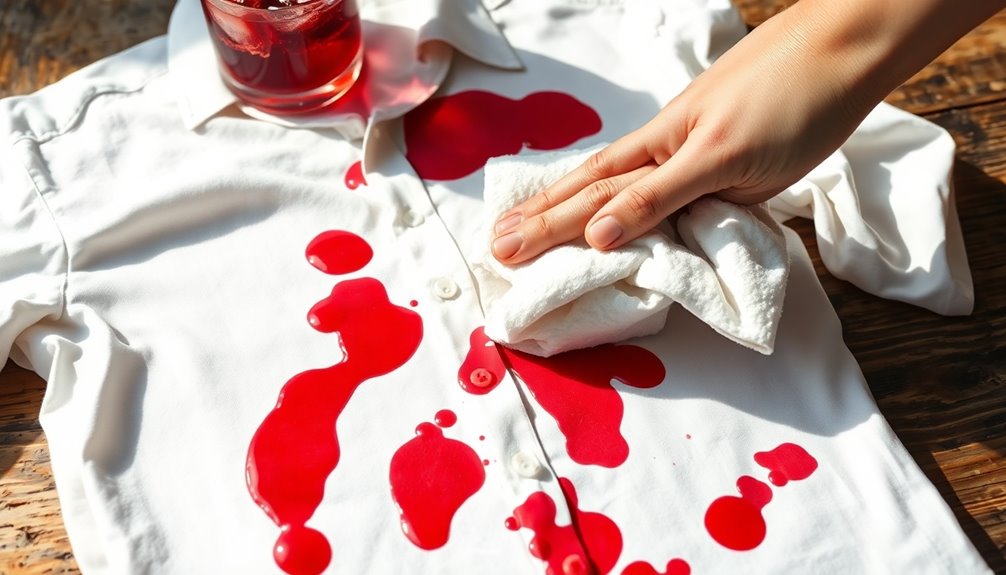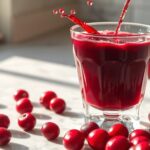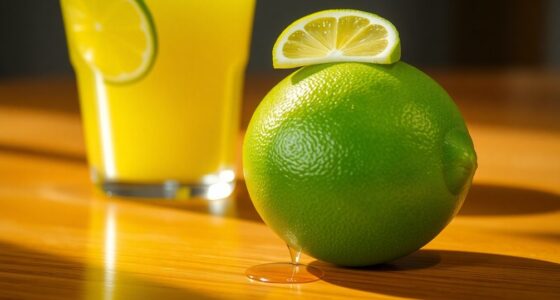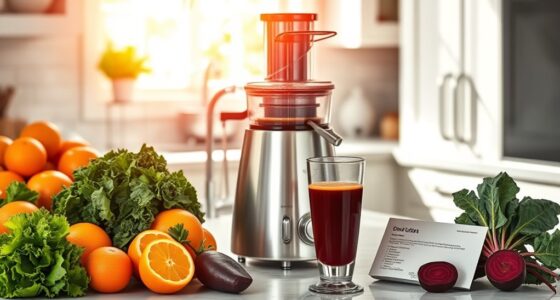If you spill cranberry juice on your white shirt, act fast! Blot the stain with a clean cloth to absorb excess liquid without rubbing. Rinse the area with cold water for 1-2 minutes to dilute the juice. Next, apply an enzyme-based stain remover and let it sit for at least 15 minutes. Wash the shirt in the hottest water safe for the fabric. If the stain lingers, you'll want to repeat the process for the best results.
Key Takeaways
- Blot the cranberry juice stain immediately with a clean cloth to absorb excess liquid and prevent spreading.
- Rinse the stained area under cold running water for 1-2 minutes to dilute the juice.
- Apply an enzyme-based stain remover or heavy-duty detergent, working it into the fabric for thorough coverage.
- Wash the shirt in the hottest water allowed by the care label to help eliminate remaining stain traces.
- If the stain persists, repeat the treatment and air dry until completely confident the stain is gone.
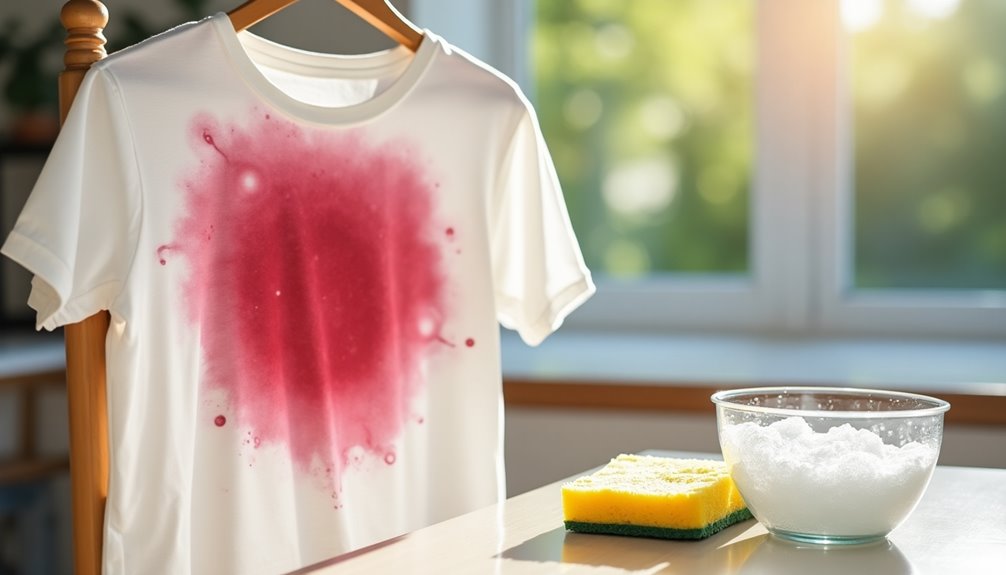
When you accidentally spill cranberry juice on your favorite white shirt, don't panic; you can tackle the stain effectively. The first step is to act quickly. Grab a clean white cloth or a paper towel and gently blot the stain. Make sure you're absorbing the excess liquid without rubbing the fabric—this helps prevent the stain from spreading or setting deeper into the fibers. Remember, the quicker you respond, the better your chances of completely removing the stain.
Once you've blotted the area, it's time to rinse. Head to the sink and run cold water over the stained spot. You want to dilute the cranberry juice as much as possible. Rinsing with cold water is crucial because hot water can set stubborn stains like cranberry juice. Let the water flow through the fabric for a minute or two to help lift the juice out.
After rinsing, you'll need to apply a stain remover or a heavy-duty laundry detergent directly to the stain. Choose an enzyme-based stain remover if you have one—these are particularly effective for organic stains like cranberry juice. Gently work the stain remover into the fabric with your fingers, making sure to cover the entire stained area. Allow it to sit for at least 15 minutes. This waiting time is essential for the product to break down the stain effectively.
Once the time's up, it's time to wash the shirt. Check the care label for the hottest water setting that's safe for the fabric. Washing in hot water can help remove any remaining traces of the stain, but always follow fabric care guidelines to avoid damage.
When you put your shirt in the washing machine, make sure to keep an eye on the stained area after the wash cycle. If you still see discoloration, don't dry the shirt just yet; heat from the dryer can set the stain permanently.
If the stain persists, repeat the treatment process. Apply the stain remover again, let it sit, and then wash it as before. You might've to do this a couple of times, especially with stubborn stains, but persistence pays off.
Always air dry the shirt instead of using the dryer until you're confident the stain is gone.
Frequently Asked Questions
Do Cranberry Juice Stains Come Out?
Yes, cranberry juice stains can come out if you act quickly.
First, rinse the stained area with cold water to dilute the juice.
Then, apply an enzyme-based stain remover or heavy-duty detergent directly on the stain.
For tougher stains, consider soaking the fabric in a solution of oxygen bleach and water, if safe for the shirt.
Lastly, air dry the shirt instead of using a dryer to prevent setting any remaining stain.
How to Remove Cranberry Juice Stains From White Clothes?
To remove cranberry juice stains from white clothes, start by blotting the stain with a clean cloth to absorb excess juice.
Rinse the area under cold water, flowing from the back to push the stain out.
Apply an enzyme-based stain remover and let it sit for 15 minutes.
Wash the garment in hot water safe for the fabric, adding bleach if allowed.
Air dry and check for any remaining stains before using a dryer.
How to Get Cranberry Sauce Out of a White Shirt?
Imagine the joy of a festive meal suddenly marred by a cranberry sauce stain on your favorite white shirt.
Don't panic! Quickly blot the stain with a clean cloth to absorb excess sauce.
Rinse the area under cold water, flushing from the back.
Apply an enzyme-based stain remover, letting it sit for 15 minutes.
Wash in the hottest water safe for the fabric, then air dry and check for lingering stains.
Is Cranberry Juice Hard to Get Out of Clothes?
Cranberry juice can be tough to get out of clothes, especially if you don't act quickly. The natural pigments in the juice can bond with fabric fibers, making stains harder to remove over time.
If you tackle the stain right away, you've got a better chance of success. Use cold water and an enzyme-based remover, but avoid heat until you're sure the stain's gone.
Testing solutions first helps protect your fabric, too.
Conclusion
Now that you've tackled that stubborn cranberry juice stain, imagine your white shirt gleaming like fresh snow under the sun. With a bit of patience and the right techniques, you've transformed a potential fashion disaster into a triumph. Remember, stains don't have to spell doom for your favorite garments. So, the next time life spills a little color on your clothes, you'll be ready to reclaim your wardrobe with confidence and ease!
Cindy thoroughly researches juicing trends, techniques, and recipes to provide readers with practical advice and inspiration. Her writing style is accessible, engaging, and designed to make complex concepts easy to understand. Cindy’s dedication to promoting the advantages of juicing shines through her work, empowering readers to make positive changes in their lives through the simple act of juicing.

